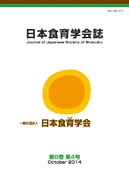Volume 7, Issue 2
Displaying 1-6 of 6 articles from this issue
- |<
- <
- 1
- >
- >|
Original papers
-
2013Volume 7Issue 2 Pages 119-128
Published: April 25, 2013
Released on J-STAGE: January 29, 2016
Download PDF (573K) -
2013Volume 7Issue 2 Pages 129-136
Published: April 25, 2013
Released on J-STAGE: January 29, 2016
Download PDF (703K) -
Shokuiku Program for Desirable Dietary Habits introduced to Six Grades of Elementary School Children2013Volume 7Issue 2 Pages 137-153
Published: April 25, 2013
Released on J-STAGE: January 29, 2016
Download PDF (2725K) -
2013Volume 7Issue 2 Pages 155-160
Published: April 25, 2013
Released on J-STAGE: January 29, 2016
Download PDF (429K)
Research note
-
2013Volume 7Issue 2 Pages 161-166
Published: April 25, 2013
Released on J-STAGE: January 29, 2016
Download PDF (1386K)
Examination report
-
Improvement of Awareness of Taste by “One Pot to One Person” Cultivation of Gymnema sylvestre R. Br.2013Volume 7Issue 2 Pages 167-170
Published: April 25, 2013
Released on J-STAGE: January 29, 2016
Download PDF (441K)
- |<
- <
- 1
- >
- >|
